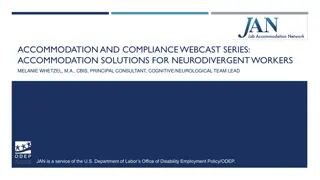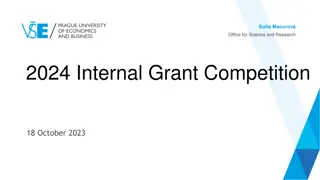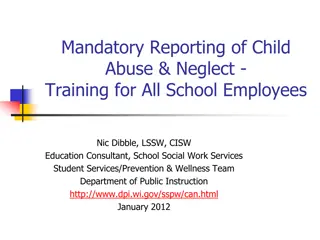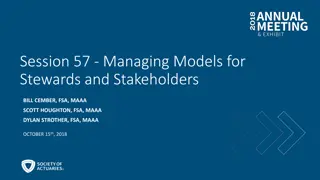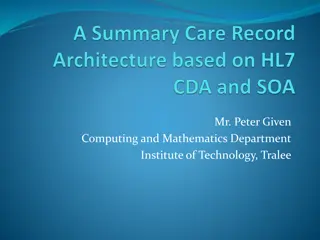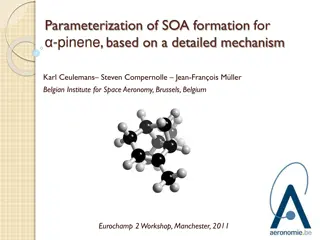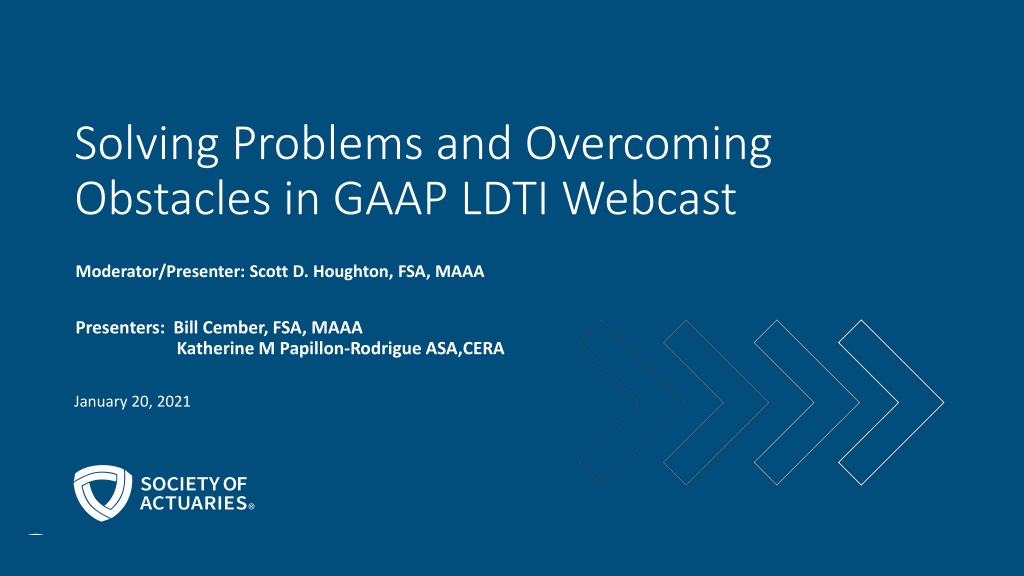
Overcoming Obstacles in GAAP LDTI Webcast
Explore the challenges and solutions in navigating GAAP LDTI regulations through a webcast featuring industry experts discussing antitrust compliance guidelines and the responsibilities of professional societies. Learn how to avoid potential legal pitfalls and ensure fair market practices in the actuarial field.
Download Presentation

Please find below an Image/Link to download the presentation.
The content on the website is provided AS IS for your information and personal use only. It may not be sold, licensed, or shared on other websites without obtaining consent from the author. If you encounter any issues during the download, it is possible that the publisher has removed the file from their server.
You are allowed to download the files provided on this website for personal or commercial use, subject to the condition that they are used lawfully. All files are the property of their respective owners.
The content on the website is provided AS IS for your information and personal use only. It may not be sold, licensed, or shared on other websites without obtaining consent from the author.
E N D
Presentation Transcript
Solving Problems and Overcoming Obstacles in GAAP LDTI Webcast Moderator/Presenter: Scott D. Houghton, FSA, MAAA Presenters: Bill Cember, FSA, MAAA Katherine M Papillon-Rodrigue ASA,CERA January 20, 2021
SOA Antitrust Compliance Guidelines SOA Antitrust Compliance Guidelines Active participation in the Society of Actuaries is an important aspect of membership. While the positive contributions of professional societies and associations are well-recognized and encouraged, association activities are vulnerable to close antitrust scrutiny. By their very nature, associations bring together industry competitors and other market participants. The United States antitrust laws aim to protect consumers by preserving the free economy and prohibiting anti-competitive business practices; they promote competition. There are both state and federal antitrust laws, although state antitrust laws closely follow federal law. The Sherman Act, is the primary U.S. antitrust law pertaining to association activities. The Sherman Act prohibits every contract, combination or conspiracy that places an unreasonable restraint on trade. There are, however, some activities that are illegal under all circumstances, such as price fixing, market allocation and collusive bidding. There is no safe harbor under the antitrust law for professional association activities. Therefore, association meeting participants should refrain from discussing any activity that could potentially be construed as having an anti-competitive effect. Discussions relating to product or service pricing, market allocations, membership restrictions, product standardization or other conditions on trade could arguably be perceived as a restraint on trade and may expose the SOA and its members to antitrust enforcement procedures. While participating in all SOA in person meetings, webinars, teleconferences or side discussions, you should avoid discussing competitively sensitive information with competitors and follow these guidelines: -Do not Do not discuss prices for services or products or anything else that might affect prices -Do not Do not discuss what you or other entities plan to do in a particular geographic or product markets or with particular customers. -Do not Do not speak on behalf of the SOA or any of its committees unless specifically authorized to do so. -Do Doleave a meeting where any anticompetitive pricing or market allocation discussion occurs. -Do Doalert SOA staff and/or legal counsel to any concerning discussions -Do Doconsult with legal counsel before raising any matter or making a statement that may involve competitively sensitive information. Adherence to these guidelines involves not only avoidance of antitrust violations, but avoidance of behavior which might be so construed. These guidelines only provide an overview of prohibited activities. SOA legal counsel reviews meeting agenda and materials as deemed appropriate and any discussion that departs from the formal agenda should be scrutinized carefully. Antitrust compliance is everyone s responsibility; however, please seek legal counsel if you have any questions or concerns.
Presentation Disclaimer Presentations are intended for educational purposes only and do not replace independent professional judgment. Statements of fact and opinions expressed are those of the participants individually and, unless expressly stated to the contrary, are not the opinion or position of the Society of Actuaries, its cosponsors or its committees. The Society of Actuaries does not endorse or approve, and assumes no responsibility for, the content, accuracy or completeness of the information presented. Attendees should note that the sessions are audio-recorded and may be published in various media, including print, audio and video formats without further notice.
TI VA Business Context Bill Cember, FSA, MAAA
Business Context Where are We? 2013 2018 2020 The FASB issued an exposure draft with proposed changes to insurance contract accounting Things are too complicated! Specific guidance issued in ASU-2018 Implementation well underway for 1/1/2023 adoption (or 1/1/2022 if early adopting) 5
Business Context Quality of Earnings - Definition Allow the performance of a company to be assessed and evaluated against comparable companies Comparability Change period-over period should be from operating performance and market changes, not accounting mismatches Sustainability Economic Value of assets/liabilities should reflect their intrinsic value 6
Business Context Fair Value Value reported is based on an unadjusted quote price from active markets E.g. value of public equity a company holds Level 1 Value reported includes items other than quoted prices that are observable to market participants E.g. value of a non life contingent payout annuity Level 2 Value reported includes at least one non- observable input E.g. value of a life contingent payout annuity Level 3 7
Business Context Quality of Earnings Valuation of Companies Annuity Living Benefit Riders Characteristic Characteristic Pre Pre- -TI TI Post Post- -TI TI Comparability Some companies value liabilities under a fair value framework (FAS 157) while others value under insurance accrual (SOP 03-1) or some combination thereof Much more comparability all companies required to value under fair value. Sustainability If liabilities valued under an insurance accrual model while hedge assets valued at fair value, then resulting changes period-of-period from accounting differences. Common framework for valuing hedge assets and liabilities Economic Only one intrinsic value, not two Fair value more economic than insurance accrual, although can be argued certain aspects (e.g. NPR spread) non-economic 8
Business Context Recent VA M&A 2017 Metlife spins-off of Brighthouse 2018 AXA spins-off Equitable 2018 Talcott Resolution becomes an independent entity from The Hartford 2018 Venerable formed as an acquisition of Voya s VA closed block. 2020 Venerable reinsures a significant portion of Equitable s VA block 9
Business Context GAAP & Non-GAAP Financial Measures Top VA writers subject to GAAP are all using non- GAAP financial measures in addition to GAAP Different treatment of living benefit riders by company Company Company GAAP GMWB GAAP GMWB Treatment Treatment Uses Additional Non Uses Additional Non- - GAAP Financial GAAP Financial Measure? Measure? Prudential Fair Value Yes Equitable Fair Value Yes Lincoln Financial Combination Yes AIG Fair Value Yes Brighthouse Combination Yes How the heck are ordinary investors supposed to understand this? How the heck are ordinary investors supposed to understand this? 10
Business Context Non-GAAP Financial Measures Example adjustments in non-GAAP financial measures Realized gains/losses associated with fair value changes on riders and hedge assets Change in reserves from benefit ratio unlocking GMIB fees & costs Covid-19 Impacts Goals Remove mismatches between assets and liabilities Remove items not expected to re-occur in the future Address non-economic nature of certain GAAP items Issues Different measures for every company Less transparency than GAAP measure around methodology Ability for management to change methodology period-over- period 11
Liability Changes DAC What DAC amortized over expected life of the contact rather than expected gross profits Other changes such as shadow DAC no longer applying, removal of need for impairment testing Why Simplified amortization and increased understandability for investors Now What? More easily predictable expense pattern for investors DAC amortization no longer dependent on investment of underwriting results 12
Liability Changes Market Risk Benefits What Reserves for annuity riders must now be measured at fair value rather than as an insurance accrual (i.e. FAS 157 rather than SOP 03-1) Why One measurement model for all companies; improved comparability for investors Now What? Greater consistency in measurement of liabilities and hedge assets Given changes in GAAP, how will companies change their non-GAAP financial measures? Are they even needed? Given changes in liability measurement, how/if will companies change how they hedge? 13
Liability Changes Enhanced Disclosures What Enhanced disclosure requirements such as quarterly liability rollforwards, actual to expected experience, and information around inputs, assumptions and methods used in valuing MRB s Why Increased transparency into liability changes and resulting comparability across companies Now What? To what extent will disclosures be useful to investors? Will enhanced disclosures and simplifications in liability measurement remove the complexity stigma around variable annuities? Will PE ratios improve? 14
Reinsurance Katherine Papillon-Rodrigue, ASA, CERA
Reinsurance What is changing? No specific changes to the reinsurance guidance Ongoing discussion in AICPA industry group Assumed Reinsurance Items item item Description Description 12A Under LDTI, what date the reinsurance contract enter date be used? Unit of Account to use in NRP calculation for reinsurance contracts with fixed non-cancellable terms 12B 12C Unit of account for assuming reinsurance that contain multiple products 16
Reinsurance What is changing? AICPA - Ceded Reinsurance Items item item Description Description 11AC Trad and Limited Pay LD Reinsurance recoverable and cost of reinsurance; application of net premium cap and floor 11B For inforce transaction, what direct liabilities to be used? 11D Accounting policy change allowed to include COR in Loss Recognition testing? 11EF MRB Fee https://www.aicpa.org/interestareas/frc/industryinsights/long-duration-insurance-accounting-issues.html 17
Reinsurance What can be done now? Review current reinsurance approximations base of direct side changes Look for guidance on similar principled regulation Canadian GAAP IFRS 17 Required disclosure vs information desired by management 18
Reinsurance Process Flow Evaluate current Infrastructure Data available and flow of it Modeling platform Ledger Initial implementation vs long term strategy 19
Assumption Setting under LDTI for Traditional and Limited Pay Contracts Scott D. Houghton, FSA, MAAA
Discount Rate Under ASU 2018-12 ASU 2018-12 Text The liability for future policy benefits shall be discounted using an upper- medium grade (low credit-risk) fixed-income instrument yield. An insurance entity shall consider reliable information in estimating the yield that reflects the duration characteristics of the liability for future policy benefits An insurance entity shall maximize the use of relevant observable inputs and minimize the use of unobservable inputs in determining the discount rate assumption. 21
Discount Rate Under LDTI Credit risk level and duration prescribed Consensus to use A rated bond yield Use of liability duration removes differences in duration risk in company investment policies Other investment risks not prescribed Some interpretation needed for liquidity risk, prepayment risk, convexity risk Observable and non-observable inputs Bond maturities limited and can be shorter than insurance liability durations Observed rates can vary based on risks 22
Discount Rate Under LDTI Representative A Bond Yields 5 4 Yield in % 3 2 1 0 0 5 10 15 20 25 30 Term To Maturity 23
Setting the Discount Rate Sample Illustrative Process Updated each reporting period Two projection runs needed Collect and analyze Collect and analyze observable input observable input Data Fit, smooth and develop Fit, smooth and develop observed yield curve or observed yield curve or rate rate Fitting Implement Implement process for review process for review and recommend and recommend assumption assumption Review and Recommend Finalize 24
Cash Flow Projection Assumptions Based on estimates of future experience without margins Mortality Mortality improvement included to extent it is part of company view for estimate of future experience Morbidity Based on expected incidence of disability and claim cost Vary by contract type, class, gender, age, and benefit period Termination Amounts can vary based on plan, issue year, premium mode, and other factors Include lapses on products without cash surrender value Expense Separation of expense amounts needed to administer benefits 25
Cash Flow Projections Assumptions Assumption updates and breakdowns ASU 2018-12 Summary: review and, if there is a change, update the assumptions used to measure cash flows at least annually Updates Disclosures required that illustrate actual and expected (based on assumptions) at different levels of grouping Breakdowns 26
Reporting Assumptions Assumptions more granular due to required disclosures under LDTI ASU 2018-12 The balance of capitalized acquisition costs shall be reduced for actual experience in excess of expected experience (that is, as a result of unexpected contract terminations). Required disclosures and rollforwards of actual and expected experience 27
Information Needed Sample data for reporting Period Q1 2023 28
Math in LDTI Assumption Setting Process Credibility Theory Appropriate weighting of company experience Formula Fitting Non-linear regression Statistical Testing Rejection tests 29
Sources of Information Augmenting Company Experience for Setting Assumptions under LDTI Company Company experience Reinsurers have access to larger pools of information Reinsurers Industry Industry data for comparable products 30
Comparison of Assumptions Assumption Setting Under Different Standards Standard Standard Assumptions Assumptions Assumption Updates Assumption Updates (ASC) 944- -60 GAAP Pre-LDTI 60-25-9,(FAS60) Best estimate plus provision for risk of adverse deviation Locked in* Life Products under VM-20 Prudent estimate = Anticipated experience plus margin for adverse deviation Mortality at least triennially** LDTI Best estimate of future experience Review annually and update if there is a difference 31
Changes to Assumption Setting Process Changes under LDTI to make process formal and consistent Assumption Review and Recommendation Process Experience Studies Assumption Approval Process Finalize Need granular groupings of data to determine actuals Need to know actual and expected Processes need consistency from period to period Formal approval and sign off Need to state criteria for approval 32
Controls on Assumption Setting under LDTI Controls and checks required on the data process, including files, collection, validation Data Studies written and follow actuarial standards Controls applied to process Experience Studies Assumption Review and Recommendation Process needs to be documented Controls applied to process Approval Process needs documentation and controls applied 33
Long Duration Insurance Products Impact of LDTI based assumptions for LTDI, LTCI, and life products Book value accounting goes into retirement Life Disability Income ALR similar to life products DLR similar to current treatment Long Term Care Unlocking of interest and morbidity 34
Please remember to complete the webcast evaluation: http://soa.qualtrics.com/jfe/form/SV_2bJ5s2qXY8PoWpf 36




